Recent excavations in Rome have re-ignited the debate over whether the legendary first king of Rome, Romulus, was a historical character or just a fanciful work of fiction. In fact, earlier this year, archaeologists unearthed an alleged shrine to Romulus that dates from around 2,600 years ago. Beyond this find, archaeologists over the past decades have made discoveries that seem to relate to Rome’s canonical foundation myth. While the majority of academics have long written Romulus off as a “literary fabrication,” some have challenged this prevailing opinion and raised new evidence; but is there enough to finally settle the dispute?
The Case Against King Romulus’ Existence
The case against the legendary Roman founder and king, Romulus, is pretty simple: There are fantastic episodes within the Romulus tale that simply cannot be true. After all, to say the least, it seems highly unlikely that Romulus was the son of the god Mars , was rescued by a wild carnivorous she-wolf, and miraculously ascended into the heavens whereupon he became the god Quirinus who watched over the Roman state. If these dubious stories weren’t damning enough, there are other, competing Roman foundation legends that do not center around an eponymous hero.
In addition to these matters, some academics have contended that the archaeological dating of Rome doesn’t align with the city’s purported foundation in 753 BC, and there is very little, if any, compelling early evidence of King Romulus’ existence . While Romulus’ skeptics make many fair points, they don’t necessarily close the case against an eponymous founder of Rome.
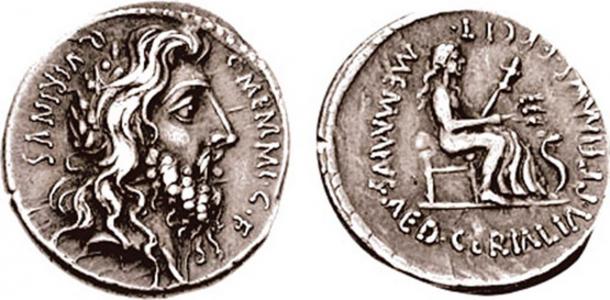
Denarius featuring the laureate, long-haired, and bearded head of Quirinus (Romulus). (Classical Numismatic Group, Inc./ CC BY SA 3.0 )
Real World Explanations for the Romulus Legends
First of all, simply because supernatural components exist within the Romulus legend doesn’t mean that the notion of a hero founder is without any credence – especially considering that there were more plausible, ancient alternatives. For one, some ancient historians believed that Romulus’ father wasn’t the god of war. Rather, an admirer or the rogue king of Alba Longa – Amulius – savagely raped and impregnated Romulus’ mother – known as Rhea Silvia – leading to the scandalous pregnancy.
The she-wolf legend is also of questionable origin, given that wolves are more likely to devour infants than nursing them. However, some ancient historians alleged that a wolf named Lupa didn’t aid little Romulus. Instead, a prostitute did, and the justification for this belief is that lupa was an ancient term which essentially translated to “whore.” So, a prostitute – possibly named Acca Larentia – rather than a wolf might have cared for Romulus.
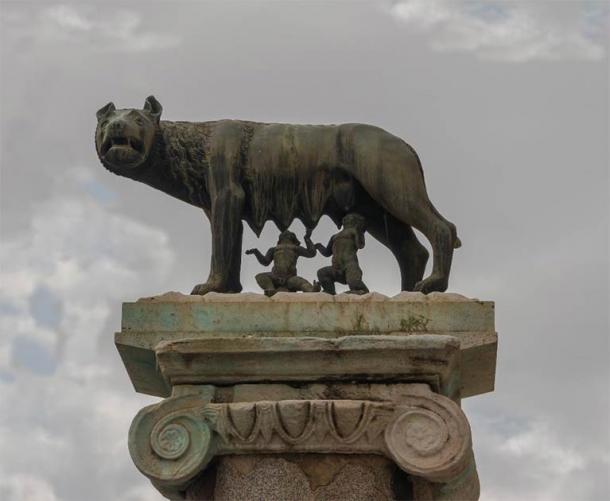
Replica of the roman she-wolf, Romulus and Remus, Capitole, Rome, Italy. ( CC0)
Finally, Romulus’ ascension into the heavens should be cause for skepticism. Most modern thinkers require proof of some sort when confronted with tales of individuals supposedly de-materializing and becoming veritable deities – especially those belonging to the pantheons of what are now dead religions. But some Roman and Greek writers believed that the truth about Romulus’ death and disappearance was much simpler: A cadre of Romans tired of King Romulus ’ despotic and unfair reign , ruthlessly killed him , dismembered his body , hid the remains, and then told everyone that he had undergone a miraculous apotheosis.
Thus, the existence of supernatural episodes in the canonical legend isn’t necessarily a strike against Romulus, given that more plausible ancient alternatives existed. The spectacular components might have just been created to bolster King Romulus’ reputation and conceal unsavory truths from the Roman public.
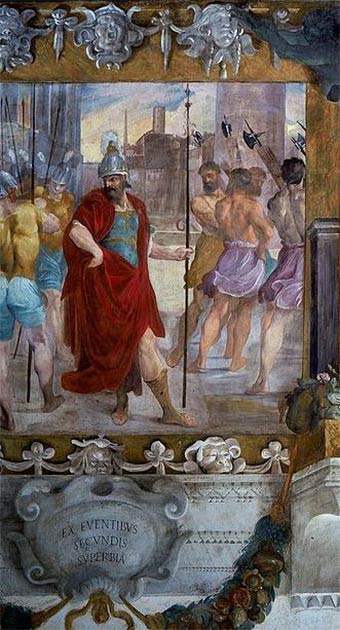
The Pride of King Romulus. ( Public Domain )
The Views of Myths and Modern Archaeology
The ancient writers knew of different foundation myths that varied beyond even these. Dionysius of Halicarnassus mentioned that he knew of 14 legends, Plutarch recalled 13, Festus 10, and Servius 8, but the esteemed modern historian T.P. Wiseman claimed to have discovered at least 60 different accounts that are extant in some form. Some are similar to the canonical version; others vary considerably; there are numerous different names of Rome’s founder and first king, including Rhomos, Rhomus, Rhomylos, and of course Romulus (many of these variants have different genealogies too); and some narratives don’t even mention an eponymous founder at all. Indeed, Plutarch wrote , “Some say that the Pelasgians, after wandering over most of the habitable earth and subduing most of mankind, settled down on that site, and that from their strength in war they called their city Rome.”
Ordinarily, the numerous contradicting narratives would be convincing evidence against the existence of a hero founder of Rome, but the majority of the accounts assert that someone – whose name was either Romulus or a similar derivative – played a critical role in Rome’s founding . What’s more, whenever dates were included, the ancients largely agreed that Rome was established around 800-700 BC.
Numerous modern academics have rejected this dating and claim that the physical evidence doesn’t corroborate this. However, finds over the past decades have challenged this point of view. According to modern archaeologist Andrea Carandini – who is not without some controversy – an ancient Palatine Hill wall, pavement from the Roman Forum, votive artifacts, and even remnants of a regal house on the Palatine have all been discovered and date to around 800-700 BC.
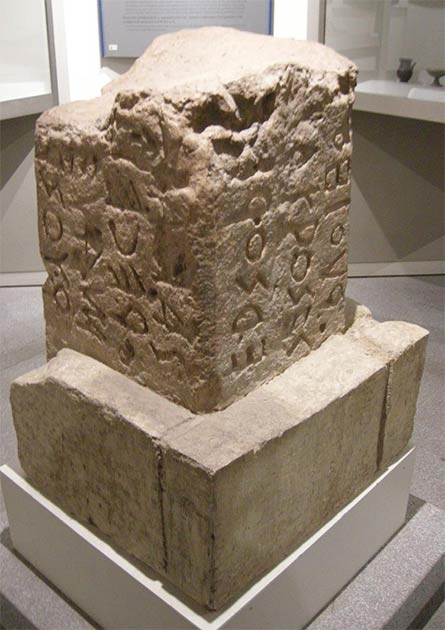
Reproduction of the Lapis Niger stone block with the inscription in Old Latin. (Sailko / CC BY-SA 3.0 ) Ancient Romans believed the Lapis Niger marked either the grave of the first king of Rome, Romulus, or the spot where he was slain by the senate, or the location where Faustulus, the foster father of Romulus fell in battle.
Many of these finds seem potentially related to the Romulus myth too. After all, he was alleged to have constructed a wall on the Palatine, possibly prepared the Forum for usage, raised temples where votive relics have been found, and even erected a home on the Palatine. While these archaeological finds are fascinating, regrettably, none of them conclusively confirm Romulus’ existence.
Romulus’ skeptics also point out that the earliest known writings and artifacts recounting or at least alluding to the Romulus myth come hundreds of years after he supposedly died. The first known writing mentioning a hero founder dates to the mid fourth century BC, and the first undisputed, well-attested art and coinage depicting Romulus dates to 296 and 269/268 BC, respectively. The former was a statue of Romulus, Remus, and Lupa, and the latter was a silver coin featuring the trio on the obverse.
This is long after Romulus supposedly lived, but this is hardly definitive evidence against him, considering that Roman writing and art was relatively sparse for much of its early history. Further, the annalist Livy asserted that much of Rome’s priceless corpus of early documents was lost during the Gallic sacking of Rome around 390 BC – although modern historians question the true extent of the destruction. All of this aside, it seems safe to assume that the bulk of Rome’s earliest documents and art may not have survived to the modern era.
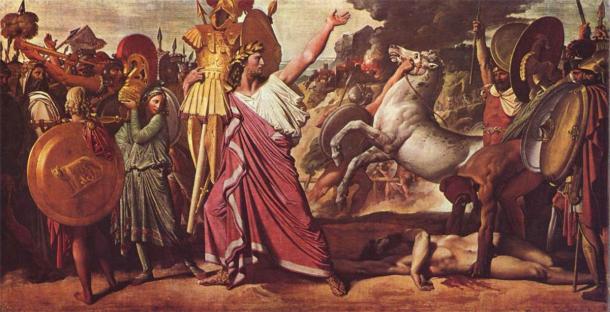
Romulus, Victor over Acron, hauls the rich booty to the temple of Jupiter. ( Public Domain )
Finding Fact in Fiction?
If we are being honest, then in the end, the evidence for and against Romulus is weak at best. The archaeological, artistic, and numismatic evidence is inconclusive, which only leaves the literary record. Plutarch insisted that the notion of an eponymous founder was the “most authentic tradition,” and Dionysius of Halicarnassus – who chronicled a detailed history of early Rome – claimed to have relied on the “best accredited” historians and accounts.
While the extant records of Rome’s founding are woefully deficient, most of the accounts appear to support the theory of an eponymous hero founder. While this isn’t necessarily proof of Romulus per se , the majority consensus within the written histories seem to suggest that someone named Romulus or something similar was integral to Rome’s founding around 800-700 BC.
And this could plausibly be the case. After all, it is more logical to accept that there’s a kernel of truth within a legend for which there is ample literary evidence, despite its shortcomings, and some potentially supporting ancillary archaeological evidence as opposed to believing in something when there’s far less, if any, proof.
Perhaps where there is smoke there is fire and maybe there’s a morsel of truth within some of Rome’s foundation myths. Remember that before Heinrich Schliemann discovered and excavated Troy, his contemporaries almost universally believed that Troy and the famed Trojan War were creations of fiction. Yet they were proven wrong, and it turned out that there were slivers of truth in the ancient accounts. Maybe it is the same with the varying Roman foundation myths and Rome was named after a person who loomed large in its early history.
The writer and philosopher Albert Camus is thought to have said, “Fiction is the lie through which we tell the truth,” and this quote seems to have special significance with regards to the Romulus debate. Rome’s founding is shrouded in uncertainty, and it is obscured by the passage of time and literary embellishments and creations. However, it is possible that these were the lies through which the ancients told the truth .
Top Image: Did Romulus, the legendary first king of Rome, ( neurobite /Adobe Stock) really exist? ( samott /Adobe Stock)
By Marc Hyden
Marc Hyden is the Director of State Government Affairs at the R Street Institute. He is also the author of “ Romulus: The Legend of Rome’s Founding Father ” and “ Marius: The Rise and Fall of Rome’s Saviour .”
 RSS Feed
RSS Feed















 December 8th, 2020
December 8th, 2020  Awake Goy
Awake Goy  Posted in
Posted in  Tags:
Tags: 













